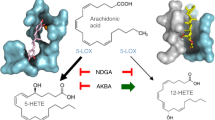Abstract
BAY X1005, (R)-2-[4-(quinolin-2-yl-methoxy)phenyl]-2-cyclopentyl acetic acid, is an enantioselective inhibitor of leukotriene biosynthesis. It effectively inhibits the synthesis of LTB4 in A23187-stimulated leukocytes from rats, mice and humans (IC50 0.026, 0.039 and 0.22 μmol/l, respectively) as well as the formation of LTC4 (IC50 0.021 μmol/l) in mouse peritoneal macrophages stimulated with opsonized zymosan. The compound is, however, less active in inhibiting LTB4 synthesis in human whole blood (IC50 17.0 and 11.6 μmol/l, as measured by RIA or HPLC, respectively). BAY X1005 exhibits a high enantioselectivity in human whole blood (31 times over the (S)-enantiomer). BAY X1005 is shown to be a selective inhibitor of the formation of 5-lipoxygenase-derived metabolitesin vitro, without effects on other routes of arachidonic acid metabolism such as 12-lipoxygenase in human whole blood and cyclooxygenase in both mouse macrophages and human whole blood. BAY X1005 is devoid of any antioxidant activity (methemoglobin induction and xanthine-xanthine oxidase assay), without effects on granule release and with only weak effects on reactive oxygen species generation in human PMNL.
Similar content being viewed by others
References
R. A. Lewis, K. F. Austen and R. J. Soberman,Leukotrienes and other products of the 5-lipoxygenase pathway — Biochemistry and relation to pathobiology in human diseases. New Engl. J. Med.323, 645–655 (1990).
P. J. Gardiner,Inhibitors of the biosynthesis or actions of the leukotrienes. Asthma Rev.2, 75–123 (1989).
K. F. Austen,The role of arachidonic acid metabolites in local and systemic inflammatory processes. Drugs33, 10–17 (1987).
J. H. Musser and A. F. Kreft,Substituted-[2-quinolinyl (bridged) aryl] compounds: Modulators of eicosanoid biosynthesis and action. Drugs Future15, 73–80 (1990).
G. A. Higgs, R. J. Flower and J. R. Vane,A new approach to anti-inflammatory drugs. Biochem. Pharmacol.28, 1959–1961 (1979).
S. M. Coutts, A. Khandwala, R. van Inwegen, U. Chakraborty, J. Musser, J. Bruens, N. Jarivala, V. Dally-Meade, T. Pruss, H. Jones, E. Neiss and I. Weinryb,Arylmethyl phenyl esters a new class of specific inhibitors of 5-lipoxygenase. InProstaglandins, Leukotrienes and Lipoxins. (Ed. J. Martyn Bailey) pp. 627–637, Plenum Press, New York 1985.
Y. Ashida, T. Saijo, H. Kuriki, H. Makino, S. Terao and Y. Maki,Pharmacological profile of AA-861, a 5-lipoxygenase inhibitor. Prostaglandins26, 955–970 (1983).
G. W. Carter, P. R. Young, D. H. Albert, J. Bouska, R. Dyer, R. L. Bell, J. B. Summers and D. W. Brooks,5-Lipoxygenase inhibitory activity of zileuton. J. Pharmacol. Exp. Ther.256, 929–937 (1991).
J. W. Gillard, A. W. Ford-Hutchinson, C. Chan, S. Charleson, D. Denis, A. Foster, S. Leger, C. S. McFarlane, H. Morton, H. Piechuta, D. Riendeau, C. Rouzer, J. Rokach, R. Young, D. E. MacIntyre, L. Peterson, T. Bach, G. Eiermann, S. Hopple, J. Humes, L. Hupe, S. Luell, J. Metzger, R. Meurer, D. K. Miller, E. Opas and S. Pacholok,L-663,536 (MK-886) (3-[1-(4-chlorobenzyl)-3-t-butylthio-5-isopropylindol-2-yl]-2,2-dimethylpropanoic acid), a novel, orally active leukotriene biosynthesis inhibitor. Can. J. Physiol. Pharmacol.67, 456–464 (1989).
K. A. Evelyn and H. T. Malloy,Microdetermination of oxyhemoglobin, methemoglobin and sulfhemoglobin in a single sample of blood. J. Biol. Chem.126, 655–662 (1938).
R. J. Tallarida and L. S. Jacob, The Dose-Response Relation in Pharmacology, pp. 99–103. Springer, New York 1979.
A. Hatzelmann, R. Fruchtmann, K. H. Mohrs, S. Raddatz and R. Müller-Peddinghaus,Mode of action of the new selective leukotriene synthesis inhibitor BAY X1005, (R)-2-[4-(quinolin-2-yl-methoxy)phenyl]-2-cyclopentyl acetic acid, and other structurally-related compounds. Biochem. Pharmacol. (in press).
J. F. Evans, C. Léveillé, J. A. Mancini, P. Prasit, M. Thérien, R. Zamboni, J. Y. Gauthier, R. Fortin, P. Charleson, D. E. Macintyre, S. Luell, T. J. Bach, R. Meurer, J. Guay, P. J. Vickers, C. A. Rouzer, J. W. Gillard and D. K. Miller,5-Lipoxygenase-activating protein is the target of a quinoline class of leukotriene synthesis inhibitors. Mol. Pharmacol.40, 22–27 (1991).
A. W. Ford-Hutchinson,FLAP, a novel drug target for inhibiting the synthesis of leukotrienes. Trends Pharmacol. Sci.12, 68 (1991).
L. Ménard, S. Pilote, P. H. Naccache, M. Laviolette and P. Borgeat,Inhibitory effects of MK-886 on arachidonic acid metabolism in human phagocytes. Br. J. Pharmacol.100, 15–20 (1990).
Author information
Authors and Affiliations
Rights and permissions
About this article
Cite this article
Fruchtmann, R., Mohrs, K.H., Hatzelmann, A. et al. In vitro pharmacology of BAY X1005, a new inhibitor of leukotriene synthesis. Agents and Actions 38, 188–195 (1993). https://doi.org/10.1007/BF01976210
Received:
Accepted:
Issue Date:
DOI: https://doi.org/10.1007/BF01976210




